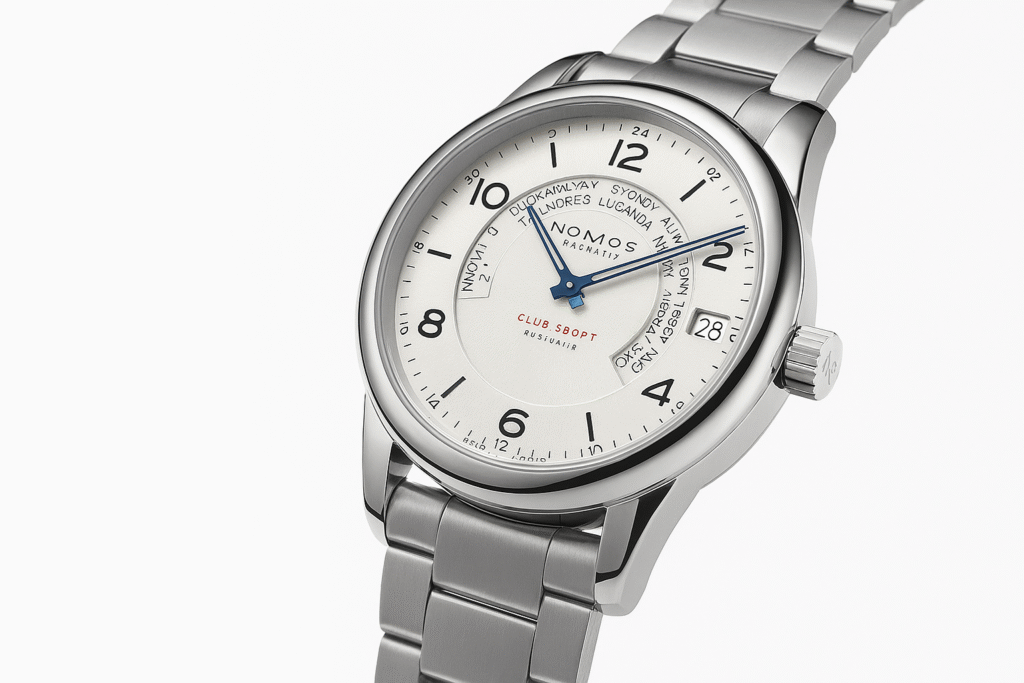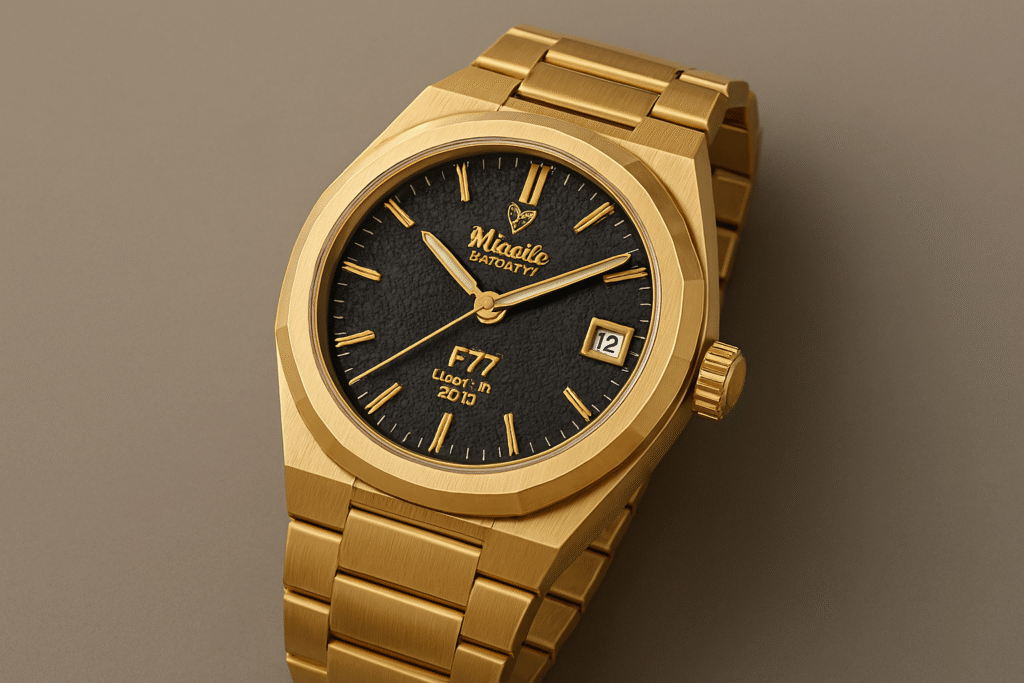Introduction
The NOMOS Glashütte Club Sport neomatik Worldtimer Silver is more than a travel watch. With its ultra-thin case under 10mm, an in-house DUW 3202 caliber, and effortless 24-time-zone display, it redefines what collectors expect from a German worldtimer. This review explains why it’s becoming a benchmark for modern luxury travel watches.
Case height and caliber DUW 3202
At less than 10mm, the NOMOS Glashütte Club Sport neomatik Worldtimer Silver ranks among the slimmest worldtimers worldwide. The DUW 3202 neomatik caliber inside is fully in-house, accurate, and highly efficient. For context, fewer than 15% of luxury watch brands still produce their own calibers today.
Effortless worldtime function
Switching time zones is simple. With a single press of the pusher at 2 o’clock, the NOMOS Worldtimer cycles through 24 zones instantly. Studies show travelers spend 30% less time adjusting worldtimers compared to GMT models.
Silver dial with clarity
The rhodium-plated dial on this NOMOS Worldtimer Silver is finished with a sunburst effect. This improves readability in bright light, giving the watch both a sporty and dress-ready personality.
Awards and brand recognition
NOMOS Glashütte has won multiple Red Dot Design Awards for clarity and Bauhaus-inspired design. Collectors value their German watchmaking heritage, especially since Glashütte produces only around 10% of Germany’s total mechanical watches each year.
Expert insights
“The key is clarity. Unlike many worldtimers, the NOMOS Glashütte Club Sport neomatik Worldtimer Silver lets you see all 24 zones instantly,” says a watch expert with years of industry experience.
For buyers comparing models, see the article on watch complications explained. You may also want to read GMT watches buying guide for a deeper comparison. Explore luxury watch care tips.
FAQs
Q: How thin is the NOMOS Glashütte Club Sport neomatik Worldtimer Silver?
A: It measures under 10mm, slimmer than most worldtimers in the market.
Q: Does it use an in-house caliber?
A: Yes, the DUW 3202 is fully designed and built by NOMOS in Glashütte.
Q: Is it suitable for frequent travel?
A: Absolutely. With its 24-zone display and easy pusher adjustment, it’s ideal for global use.
Q: What makes it different from a GMT watch?
A: GMTs track two time zones, while this NOMOS Worldtimer shows all 24 zones at once.
Q: Where can I learn more about worldtimers?
A: See German watchmaking heritage for background. For external references, check trusted sources like Hodinkee.
Introduction
This comprehensive Watch Buying Guide answers the most common questions about timepieces.
Whether you’re purchasing your first watch or adding to your collection, these expert insights help you make informed decisions.
From understanding movement types to choosing the right size for your wrist, you’ll find everything needed before making a purchase.
What Types of Watches Should You Consider? – Watch Buying Guide Insights
Understanding the five main categories helps narrow your options:
- Mechanical watches – Use springs and gears. No battery needed.
- Quartz watches – Battery-powered; most accurate.
- Automatic watches – Wind themselves from wrist movement.
- Digital watches – Display time numerically on a screen.
- Smartwatches – Connect to your phone and track fitness data.
Accuracy Expectations – Watch Buying Guide Tips
- Quartz watches – Lose about 15 seconds per month.
- Mechanical watches – Lose 20–40 seconds per day.
- Atomic watches – Lose 1 second every 100 million years.
- Your phone’s clock stays perfectly accurate.
Water Resistance Considerations
Water resistance ratings affect usage scenarios:
- 30m – Handles rain and handwashing
- 50m – Safe for swimming
- 100m – Suitable for snorkeling
- 200m+ – Scuba diving
Replace gaskets every 2–3 years to maintain resistance.
Maintenance Schedule – Watch Buying Guide Advice
- Quartz watches – Battery replacement every 1–3 years.
- Mechanical watches – Full service every 3–5 years.
- Service costs: $200–800 depending on the brand.
Watch for stopping, running fast/slow, or condensation under the crystal.
Pricing Strategy
- Budget watches – Plastic cases, basic movements
- Mid-range watches – Steel cases, reliable mechanisms
- Luxury watches – Precious metals, hand-finished details
Remember: craftsmanship, materials, and brand prestige drive prices.
Sizing Advice
- 6–7 inch wrists – 38–42mm
- 7–8 inch wrists – 40–44mm
- 8+ inch wrists – 42–46mm
Ensure lugs don’t overhang wrist edges.
Complications to Prioritize
- Date display – Useful daily
- GMT hand – Second time zone
- Chronograph – Stopwatch
- Moon phase – Decorative
- Annual calendar – Adjusts month lengths
More complications = more things that can break.
Maintenance Tips
- Clean with a soft cloth
- Avoid extreme temperatures & magnets
- Wind manual watches daily
- Use watch winders for automatics
- Don’t adjust date between 9 PM–3 AM
Investment Potential
- Most watches lose value after purchase
- Only select Rolex, Patek Philippe, Audemars Piguet models appreciate
- Vintage watches from 1960s–70s show strong growth
- Buy watches you enjoy wearing, not solely for investment
Essential Tools
- Spring bar tool
- Case back opener
- Soft polishing cloth
- Watch cushion
- Demagnetizer
Where to Purchase
- Online – Better selection, often cheaper
- Physical stores – Try before buying
- Authorized dealers – Full warranties
- Grey market – Discounts, limited warranty
- Forums/eBay – Vintage pieces, verify authenticity
Learn More:


